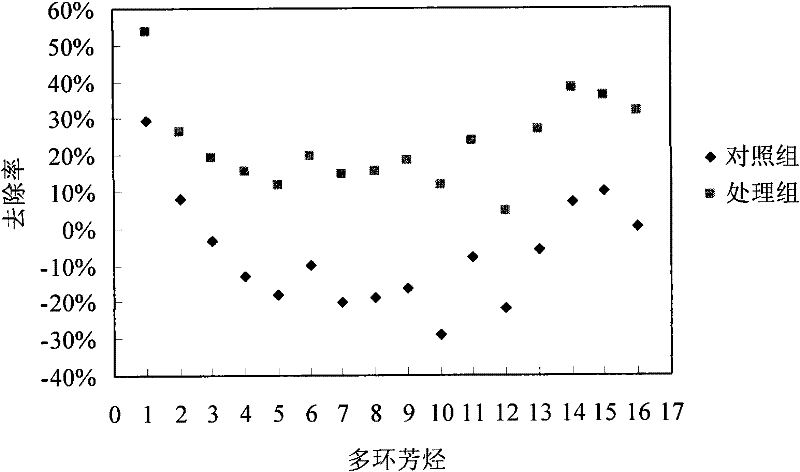Fungicide for removing and/ or degrading polycyclic aromatic hydrocarbon and application thereof
A technology of polycyclic aromatic hydrocarbons and bacterial agents, which is applied in the biological field and can solve problems affecting the degradation rate, etc.
- Summary
- Abstract
- Description
- Claims
- Application Information
AI Technical Summary
Problems solved by technology
Method used
Image
Examples
Embodiment 1
[0028] Example 1, Isolation and Identification of Polycyclic Aromatic Hydrocarbon Microbial Degradation Bacteria
[0029] 1. Separation
[0030] The polluted soil of the Beijing Coking Plant was inoculated into LB medium, cultured at room temperature (25-30°C) for one week, and 16 different polycyclic aromatic hydrocarbons (naphthalene NAP, acenaphthylene ANY, acenaphthylene ANE, Fluorene FLE, phenanthrene PHE, anthracene ANT, fluoranthene FLA, pyrene PYR, benzanthracene BaA, chrysene CHR, benzo[b]fluoranthene BbF, benzo[k]fluoranthene BkF, benzo[a]pyrene BaP, Indeno[1,2,3-cd]pyrene IcdP, dibenzoanthracene DahA, benzo[ghi]perylene (BghiP) were the only carbon sources, and different PAH-degrading bacteria in the soil were tested according to the plate streak method. isolated to obtain single colonies. Pick a single colony and inoculate it into a liquid medium with the corresponding polycyclic aromatic hydrocarbons as the sole carbon source. After cultivating at room temperatu...
Embodiment 2
[0041] Embodiment 2, the preparation of the bacteria agent that removes polycyclic aromatic hydrocarbons and / or degrades polycyclic aromatic hydrocarbons
[0042] 1. Preparation of active ingredients
[0043] Microbacterium (Microbacterium sp.) LU1 CGMCC No.3581, Paleobacterium sp. (Ochrobacterium sp.) LU2 CGMCC No.3582, Rhodococcus (Rhodococcus sp.) LU3 CGMCC No.3610 and Bordetella ( Bordetella sp.) LU4 CGMCC No.3611 were inoculated into four Erlenmeyer flasks containing 1L of fresh liquid medium, and after two weeks of cultivation, all the substances in the Erlenmeyer flasks were collected and called Rhodococcus sp. LU3 ferment, Microbacterium sp. LU1 ferment, Ochrobacterium sp. LU2 ferment, and Bordetella sp. LU4 ferment. Among them, the bacterial cell content in the fermentation product of Rhodococcus sp. LU3 is 1×10 6 CFU / ml, the cell content of Microbacterium sp. LU1 fermentation product is 1×10 6 CFU / ml, the cell content of Ochrobacterium sp. LU2 fermentation product...
Embodiment 3
[0048] Embodiment 3, the application of removing polycyclic aromatic hydrocarbons and / or degrading polycyclic aromatic hydrocarbons bacterial agents in soil remediation
[0049] PAH-contaminated soil was collected from Beijing Coking Plant for experiments. The soil texture is mainly sandy soil with clayey soil. The content of available nitrogen and available phosphorus is 60mg / kg and 3.5mg / kg respectively, and the content of total organic carbon is 0.6% (6000mg / kg), the total content of 16 polycyclic aromatic hydrocarbons is about 240-307mg / kg. Polycyclic aromatic hydrocarbons in soil were extracted by microwave, purified by column chromatography, and determined by GC-MS. The specific experimental steps are as follows: Weigh 3g of soil sample on a ten-thousandth balance and load it into a microwave extraction column, add 10mL of n-hexane and 10mL of acetone as extraction agents, and the extraction procedure is to raise the temperature to 100°C in 10 minutes and keep it for 10 ...
PUM
 Login to View More
Login to View More Abstract
Description
Claims
Application Information
 Login to View More
Login to View More - R&D
- Intellectual Property
- Life Sciences
- Materials
- Tech Scout
- Unparalleled Data Quality
- Higher Quality Content
- 60% Fewer Hallucinations
Browse by: Latest US Patents, China's latest patents, Technical Efficacy Thesaurus, Application Domain, Technology Topic, Popular Technical Reports.
© 2025 PatSnap. All rights reserved.Legal|Privacy policy|Modern Slavery Act Transparency Statement|Sitemap|About US| Contact US: help@patsnap.com

